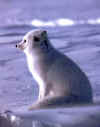 Arctic
Fox
Arctic
FoxECOLOGY
Of all the ideas and images associated with Native Americans ecology has become the hallmark of non-Indian romantic notions of a 'Noble Savage' and pan-Indian spiritual rejuvenation. Some scholars propose a model with three states of nature or three Edens. The First Eden is nature primeval; Second Eden is nature modified, disturbed, despoiled and Third Eden is nature artificial or synthetic. Unfortunately this is a Western centric model and usually Native Americans are seen as in the First Eden or that when Europeans arrived it was to a First Eden. This is not true and Native Americans certainly modified their environment. In other words America was not an undisturbed wilderness when Europeans first arrived.
The stereotypes of a perfect 'eco-person' in harmony with all of nature or at one with a wilderness is certainly wrong. Native Americans were a highly diverse people with cultures adapting to a highly varied array of American landscapes. Some Native American cultures and civilizations made numerous mistakes from a current ecological point of view. Archaeological data reveals that agricultural civilizations could quickly over tax the soil and plant communities. Sometimes adjustments could be made, but others instances reveal that abandonment and migration was the only solution. During historical contact many Native American groups found it necessary for survival to succumb to European trade goods or commodities with disastrous ecological consequences. These problems were most acute in areas where fur trade was dominant and later with mining resources. In spite of these realities it is clear that traditional and some contemporary Native American cultures viewed 'Nature' and the environment as having not 'fallen' and being an interrelated system. Western science responded to the destruction of frontier and its value after 90% of the forest was destroyed by the 1890s. Its not clear that European Americans ever listened or ever will listen to Native Americans which continues to be the primary barrier to not understanding Native American culture. The call to pay attention to the environment in Rachel Carson's Silent Spring (1960) was not heeded for quite a while as the biological sciences plugged cybernetics and systems theories into environmental research. When it was pointed out that Native Americans practiced ecological principles, obvious exceptions were used to deny any positive influence from Native American/Western culture treats Native American culture (and other indigenous people) as primitive and unsophisticated, thus unworthy of attention or validity. Some of this is a way of avoiding the truth of ecological disaster that is a great deal more severe than our culture wants to admit. Native Americans and ecological activists are perceived as impediments to progress. Progress is seen as quantitative growth. We continue to dump garbage into our oceans, pollute our air, push other life into extinction. Stupidity about the interconnectedness of the natural world is rampant or just not economically expedient.
Native American have tried to do better. They realized that at times their ancestors overtaxed the environment. Many traditional myths tell of greed and wasteful behavior. The Hopi have submitted multiple warnings and messages to the United Nations (1959-1993) asking the White Brothers to pay attention to what is being done to the environment. The Hopi want their own sacred lands left alone and protected. However, they are concerned that the entire world is moving toward ultimate disaster. Other Native Americans throughout the Americas have seen changes in their mountains and in the oceans that of great concern. The Inuit of the Far North have seen the most dramatic change with melting ice and entire villages disappearing.
Copyright � S.J. Crouthamel